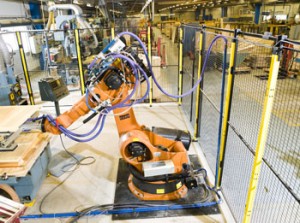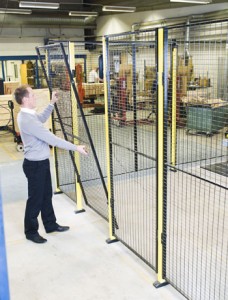Axelent examines guarding requirements for robots
 The experts from Axelent discuss the important issue of guarding for robot cells when the guard is to be positioned within the motion range of the robot.
The experts from Axelent discuss the important issue of guarding for robot cells when the guard is to be positioned within the motion range of the robot.
We are often asked about the stability of guards in connection with robot installations, where the guard (fencing) needs to be placed in the motion range of a robot because of space limitations. In such cases the robot could – due to a malfunction, programming or operating error – collide with the guard, potentially breaking through it or knocking it over. This, in turn, could cause severe injury to operators or bystanders outside the guard.
Whether or not a guard will withstand impact by a stray robot depends on the kinetic energy of the impact. Robots range from small units handling less than one kilogram to very large machines handling hundreds of kilograms. Many robots perform minute movements or move at low speed, while others perform 180-degree turns at high speed. High-speed large robots are capable of breaking large holes through brick walls and even concrete ceilings. Thus, to determine whether a guard would withstand an impact, it is necessary to know the maximum kinetic energy involved (E = 1/2 m x v², where E = energy, m = mass, v = velocity). It is given in Joules and depends entirely on the robot.
What is ‘Robot Safe’?
Some guard manufacturers might claim their guarding products to be ‘robot safe’, giving the impression that they can withstand any impact that might occur, regardless of the size and speed of the robot. It is doubtful if such claims are credible! Axelent does not claim general ‘robot safety’ for the reasons given above. Axelent guards have been tested in labs and have withstood impacts of up to 1200 Joules. For most small to medium range robot applications, this should prove sufficient.
Practical considerations
 Based on EN ISO 10218-2, Robots and robotic devices – Safety requirements for industrial robots – Part 2: Robot systems and integration, Axelent offers the following thoughts for consideration by companies operating robots behind guards:
Based on EN ISO 10218-2, Robots and robotic devices – Safety requirements for industrial robots – Part 2: Robot systems and integration, Axelent offers the following thoughts for consideration by companies operating robots behind guards:
1. Limit robot movement
In robot applications, the purpose of a guard (fencing) is to prevent access to the robot and the hazard area determined by its motion range. In our view, it is the responsibility of the designer of the robot system to limit the motion range of the robot to prevent it from colliding with objects located within its general motion range. Where linear or rotary movements occur in stationary machinery, designers will limit the motion range of axes inherently, by mechanical end stops, limit switches or monitoring.
The housing of a machine or its fixed guards are generally not capable of holding back malfunctioning parts or moving elements. On machine tools, for instance, the housings (including inspection windows) are made to withstand parts of ejected workpieces or tools, which do not exceed a certain weight and speed. However, they are not made to hold back a stray X-, Y- or Z-axis. Generally it should not be different with robots. The guard is designed to keep people out, not the robot in!
2. How to prevent collisions
A collision of the robot with the guard can be prevented by any of the following measures (or combinations of these):
- Mechanic end stops for some/all axes of the robot.
- Motion range limiting by means of hardware limit switches (roller lever or proximity type) for some/all axes.
- Collision sensors installed so that movements may be stopped early enough (difficult if motion speeds are high). Many robots are equipped inherently with force sensing to detect collisions or other malfunctions.
- A so-called ‘safe’ (high reliability) robot control system meeting a performance level ‘c’ or ‘d’ to EN ISO 13849-1. Such control systems have redundant control functions to ensure the robot does not exceed programmed motion limits. On large high-performance robots, this is probably the only feasible (but often costly) method of ensuring with maximum reliability that the robot will not exceed its boundaries and cause havoc.
3. Simulation and low-speed trials
Even if safe robot control systems are not in place, the probability of malfunctions in a robot controller is very low. Corresponding accidents are extremely rare considering the high number of robot installations. However, programming errors are a concern. All operating conditions should therefore be checked carefully by simulation and trial operation at low speeds, before a robot application is released for production.
The probability of collisions between robot and guards or loss of payload, which will then hit a guard, will be higher in some cases, notably in the case of the following: very high motion speeds; friction-type grippers (instead of positive locking grippers) for high-weight workpieces; vacuum grippers; and electromagnetic grippers).
4. Special measures
If special risks (such as those mentioned under 3) cannot be reduced sufficiently by any of the measures under 2, a type of ‘catch system’ may have to be installed in addition to the guard. This is necessary when the calculated maximum impact energy is higher than the guard can withstand. Generally, custom-made designs are required to achieve this. Some examples are: reinforced posts with support bars, stronger gratings designed to tolerate deformation and thus transform some of the kinetic energy, and double fencing with intermediate space combined with elastic ‘grating’ in the form of strong nets, plastic panes, etc.
Due to the very high kinetic energy, standardised guards or ‘catch systems’ for high-speed, high-performance robot applications are not feasible. Guard manufacturers should be able to indicate the maximum kinetic energy their product can withstand. When selecting a product, such values should be compared instead of opting for a product that bears a general claim to ‘robot safety.’
The designer of the robot application will have to do his part and should compute the worst-case kinetic energy occurring in a collision.
Visit the Axelent website for more information.
See all stories for Axelent















